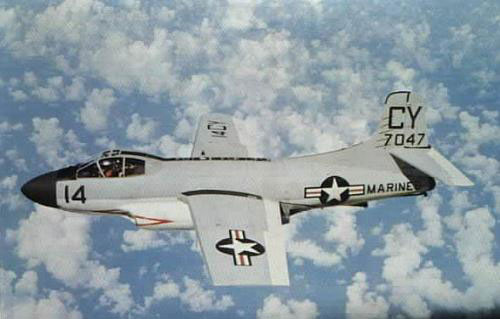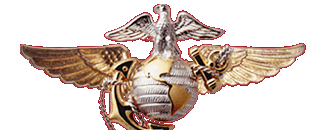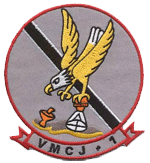MCARA War Stories
Also See:
Duke's First SAM Strike
By Duke Steinken Capt. USMC (Ret), with a prologue and epilogue by Flash Whitten Col. USMC (Ret) based on Chris Hobson’s book Vietnam Air Losses , the definitive history on US aircraft losses in Vietnam, and Iron Hand by Anthony Thornborough & Frank Mormillo
Prologue: On 5 April 1965, just 4 days before VMCJ-1 deployed to Danang RVN to provide ECM support for the initial USAF and USN Rolling Thunder strike operations against NVN, a SAC U-21 brought back pictures of the first NVN SA-2 SAM site under construction. A second site was detected in May and by July the key cities of Hanoi and Haiphong were protected by a ring of SAM sites which were off-limits to US forces. Elint intercepts of a Spoonrest target acquisition radar were reported in mid July and on 23 July an Eb-66C intercept of a Fansong target tracking radar associated with the SA-2 was reported from a site West of Hanoi. The inevitable happened the very next day when one of four USAF F-4Cs flying MIGCAP for a F-105 strike about 40 miles West of Hanoi at 20,000 feet was downed by a SAM, and the remaining three damaged by another pair of missiles. Both crewmembers ejected and captured but only one, Capt Feirn, was returned as a POW. (Capt Feirn’s B-17 had been shot down in 1944 and he spent 9 months in a Stalag!).
The loss of the F-4C resulted in lifting of the ban on attacking SAM sites and on 27 July the USAF fragged a massive strike by 48 F-105s on SAM sites No. 6 & 7 located about 10 miles apart along the Black River some 30 miles West of Hanoi and a related barracks about 5 miles away. The F-105s were backed up by 12 F4-Cs and 8 F-104Cs flying MIGCAP. This special mission was code named “Spring High” according to the VMCJ-1 Command Chronology. The F-105s employed extremely low ie ingress down to 50 ft AGL tactics against the SAM sites using a variety of conventional ordnance in keeping with the belief at the time that the greatest threat was from the radar controlled missiles and AAA. (No doubt lack of confidence in ECM at that early point in the war was also a factor)
The USAF headquarters in Saigon tasked VMCJ-1 to provide ECM support for the first F-105 strikes against the newly constructed NVN SAM sites on July 27, 1965. VMCJ-1 with its six ancient EF-10Bs was the primary squadron providing ECM support to USAF and USN air operations over NVN early on in 1965.
 The EF-10B, affectionately know as the DRUT, was a sub-sonic straight wing jet with two 20MM guns. It had an escape chute between the pilot and the ECMO instead of ejections seats. It was equipped with two internal 200 watt noise jammers and could carry external ECM pods or chaff dispensers. For most missions at the extended ranges to the deep NVN targets 300 gallon drop tanks were most often used since EF-10Bs had no aerial refueling capability.
The EF-10B, affectionately know as the DRUT, was a sub-sonic straight wing jet with two 20MM guns. It had an escape chute between the pilot and the ECMO instead of ejections seats. It was equipped with two internal 200 watt noise jammers and could carry external ECM pods or chaff dispensers. For most missions at the extended ranges to the deep NVN targets 300 gallon drop tanks were most often used since EF-10Bs had no aerial refueling capability.
For some reason or another VMCJ-1 did not have enough ECMOs to fly the six plane mission that was fragged by the USAF. I was a RIO with VMFA-542 at that time , but had previously been an EWO/ECMO with VMC and VMCJ squadrons for eight years and held an EW secondary MOS. Dink Riley, another former ECMO, then with VMFA-513, and I were requested to fly the max-go EF-10B missions. I asked my CO if I could fly the mission and he said “go ahead have fun!”.
I was teamed with Major Mitchell, the VMCJ-1 operations officer, but at the scheduled launch time our aircraft (BUNO 125849) did not have all the ECM equipment installed. The other five aircraft had to depart without us to meet their IP times. About 15 minutes later the VMCJ-1 CO came by and said they were going to cancel our mission but Major Mitchell said “no skipper we were ready to go” and we immediately taxied out and took off North.
We had been briefed to fly over water to the Haiphong area then West to our IP near the SAM sites outside of Hanoi where we would set up a race track pattern at 20,000 feet . We were about 110 miles from Danang over water abeam Vinh when I calculated we were not going to make our IP on time on the briefed course. I plotted a new direct course and we transitioned over land towards Hanoi. As we passed to the West of Thanh Hoa I intercepted numerous Fire Can fire control radars and commenced jamming them and breaking their radar lock-ons. Major Mitchell said “Duke, look out here” and I saw the entire area was black with heavy AAA flak. We got through that and arrived at our IP right on time as the F-105s began to attack the SAM sites in intervals for over 20 minutes.
Collectively, the six EF-10Bs intercepted and jammed GCI, fire control and SA-2 Fansong target tracking radars and we also dispensed chaff. The Fansong radars indicated active SAM sites and threat warnings to the strike force were given although no missiles were reported during the attack while we were on station. MIG formations were reported passing through the area during the attack but there were no engagements.
After the attack was over we did not attempt to join the other EF-10Bs as we departed alone and headed for the coast and feet wet. About 33 miles NNW of Vinh we received a MIG alert at our six at 14 miles. We had two 20MM guns, but as we crossed into NVN we test fired the guns and the port gun immediately jammed. The starboard gun fired about 5 shells and it jammed, so we had no guns! (a common occurrence!) We descended very rapidly to a low altitude over water and proceeded to Danang, where we were the first EF-10B to land.
We learned later that the USAF lost several aircraft but none to radar controlled AAA or SAMs. VMCJ-1 maintained an ECMO full time in Saigon to coordinate EW missions for the USAF and Navy. He asked the Air Force representative for some sort of unit recognition for the squadron for their role in the SAM strike operation.. He replied that they had already recommended the VMCJ crews for the DFC for heroism and extraordinary achievement in aerial flight.
One month later the CG 1st MAW ordered fighter escort for all the EF-10B missions over NVN. The first escort mission flown in August 1965 was kind of a history thing for the Marine Corps as were to be the first Marine fighters to enter communist territory since the last war. The first escorts consisted of two F-4Bs, one flown by the CO of VMFA- 513, and the other by the CO of VMFA-542 sharing the glory on this historic flight. Since I was teamed with the CO of VMFA-542, I made this mission as well.
By: Duke Steinken
EPILOGUE: Chris Hobson notes that 27 July 1965 turned out to be one of the blackest days of the war for the USAF, particularly for the close knit F-105 community. All toll, they lost six F-105s and five pilots out of 55 sorties, five of them related to the SAM strikes and one bombing a target just five miles away. Two F-105s were lost to ground fire attacking SAM site No. 7. Both pilots ejected but one drowned in the Black River and the other was captured and held till 1973. Two more F-105s received combat damage from AAA attacking site No. 6. Both were able to get their aircraft back to friendly territory but were killed in crashes.
Later, after the main attack force had departed, Dogwood flight swept into the target area to clean up anything remaining only to face a barrage of missiles forcing them over a AAA site while taking evasive action, and yet another F-105 was severely damaged. Capt. Tullo was only able to get back across the Black River before ejecting. He was rescued by the first Ch-53 Jolly Green helicopter team who executed the deepest SAR mission into NVN at that time, supported by B-57s and Navy A-1 Sandys. Two B-57s were hit but managed to get safely back to Ubon AB. To make matters worse the USAF soon learned that one of the NVN SAM sites was occupied by a dummy SA-2 system, and the supposedly non-mobile SAMs were being moved overnight from one site to another like in a shell game. (In October 1965 intelligence showed only six SAM batteries for more than thirty SAM sites)
The price for that bit of intelligence came in part with the loss of an RF-101 and pilot who was hit by AAA during a BDA run over the same SAM sites on 29 July. Again the use of high speed low level passes to get under the radar came back to bite. In a display of valor characteristic of recon pilots, Capt. Weatherby, who had gotten photos of the SAM sites a few days before, volunteered for his second mission of the day, and led a section of RF-101s to get this critical BDA. His wingman reported he took a hit before the target but refused a call to eject and completed his run. Unfortunately his aircraft exploded just after turning for home.
The lessons learned from the ill fated USAF SAM strike on 27 July were not fully appreciated by the Navy as was evident by their well intended but sadly deadly reaction to the loss of a USS Midway A-4 on the night of 11 August to a SAM. The next day TF-77 began a concentrated search and destroy effort involving many aircraft on visual reconnaissance missions.
On 12 August, another Midway A-4 was hit by AAA in the vicinity of the SAM loss and the pilot had to eject after going feet wet, followed by the loss of an F-8D and pilot also to AAA. On 13 August, known as “Black Friday” three aircraft and a pilot were lost during the SAM search, two A-4Cs and a VMCJ-1/ VFP-63RF-8A from the USS Coral Sea. The latter was flown by MCARA member Major P.A. “Skip” Manning who was hit by a large caliber AAA round that exploded his wing tank, took of the starboard wing flap leaving a 5 foot hole and twisted leading edge. Skip managed to get his crippled jet out to sea near a SAR destroyer who picked him up after he had to eject.
Several things happened as a result of these disastrous events. First, was the initiation of Iron Hand air defense suppression missions flown by specialized aircrews and equipment and finally the acceptance that ever improving ECM equipment and support and evasive tactics against the SA-2 missiles in the air would permit attacking targets from mid altitudes.


